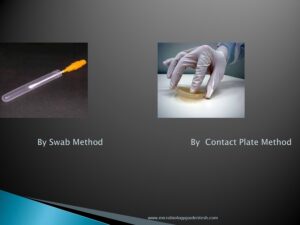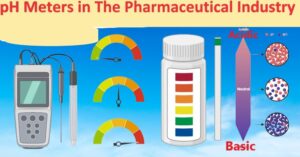Operation, Cleaning & Calibration of pH Meter.
Diffination:-
The negative logarithm of Hydrogen ion concentration is called pH.
The mathemetical formula is:

pH Meter:– A pH metre is a device that measures hydrogen ion activity in solutions; in other words, it measures the acidity/alkalinity of a solution. The level of hydrogen ion activity is finally expressed as a pH level, which typically ranges from 1 to 14.
Principle of pH meter.
The working principle of pH metres is potentiometry. This is a measurement of a solution’s electric potential (voltage). Remember how acidic solutions can efficiently conduct an electric current due to the presence of positive hydrogen ions? The ability of a solution to conduct a current is referred to as its electric potential.
1.0 OBJECTIVE
To describe the procedure for the Operation, Cleaning & Calibration of pH meter.
2.0 SCOPE
2.1 This procedure shall be applicable for the cOperation, Cleaning & Calibration of pH Meter at microbiology Department .
3.0 RESPONSIBILITY
3.1 Trained and qualified personnel shall be responsible for the cleaning, calibration and operation of pH meter as per established procedure.
3.2 Microbiology Personnel shall be responsible for ensuring that the same is carried out correctly and checking of documents for completeness of the content.
3.3 Head Microbiology/ Designee shall be responsible for compliance of the SOP.
4.0 ACCOUNTABILITY
4.1 Head- Microbiology/ Designee shall be accountable for the proper implementation of the SOP.
5.0 PROCEDURE
- Specifications of pH meter.
| Range | Resolution | Relative Accuracy | |
| pH | -2.00 – 19.999 | 0.001 pH | ± 0.002 pH |
| mV | 0 – ± 1999.9 mV | ± 0.1 mV | ± 0.2 mV |
| Temperature | 0 – 99.9 °C | 0.1 °C | ± 0.2 °C |
5.1 Operation of pH Meter.
- Ensure that the instrument is on a clean and dry platform.
- Ensure that the instrument is clean.
- Switch “ON” the main power supply to the instrument.
- Ensure that the instrument is calibrated. If the instrument is not calibrated, calibrate the instrument before use.
- Remove the pH electrode from the storage solution and rinse it with distilled water 2-3 times. Soak the excess water with the tissue paper.
- The modes can be selected by pressing MODE key repetitively till desired mode/ function is displayed.
- After desired measurement/ functional mode is displayed then ENTER key is pressed to confirm the selection.
- Insert the pH electrode and temperature sensor in a sample solution. The temperature of solution is displayed.
- Stir the sample solution keeping the pH electrode and RTD immersed.
- Allow stabilizing the pH and then record the pH. The display show on the screen.
- Rinse the electrode with distilled water and soak the excess water with tissue paper between measurements.
- After completion of pH measurement rinse the electrode and temperature sensor with distilled water, soak the excess water with tissue paper and insert the pH electrode and temperature sensor in the storage solution.
- After measurement enter the details in Annexure-I.
5.2 Calibration of pH meter.:
- Use prepared standard buffer solution (4.01, 6.86, 9.18) for pH meter calibration.
- Allow the instrument to stabilize for at least 5 minutes before performing daily calibration.
- Now insert the pH meter electrode and temperature sensor in a solution of 4.01, 6.86, 9.18 etc. wait until the reading stabilizes.
- After completion of pH calibration remove the pH and temperature sensor and rinse the electrode and temperature sensor with distilled water. Shake the electrode remove the residual solution.
- Wipe the sensor extremely with clean tissue paper without touching the bulb of pH electrode.
- The meter and sensor are now ready for the measurement of pH of the sample solution.
- The display is automatically temperature compensated for span error in pH sensor due to the temperature other than 25 °C.
- Note down the readings of buffer 4.01, 6.86, 9.18 respectively as per Annexure-II.
- After use keep the electrode dipped in the 3M KCl.
- Label the pH meter calibration status as per Annexure-III.
- Frequency of calibration: Daily before use and after maintenance.
5.3 Calculation of Slope:
- After calibration of pH meter, read the mV potential generated by the electrode in two separate calibration buffers.
- Calculate the difference in mV between the higher buffer value and the lower buffer value.
- Divide the difference in mV potential by the difference in pH unit.
- Divide this number by the theoretical maximum (59.16 mV/ pH unit at 25 ˚C) and multiply by 100 to get a percentage value of slope.
- A slope value between 80 and 120 % is acceptable.
5.4 Cleaning:
- Clean the viewing platform by 0.2 μ filtered 70 % IPA.
- Frequency – Daily or as and when required.
5.5 Precautions:
- Do not leave the electrode dry, when not in use; keep the electrodes in distilled water.
- Do not wipe the glass electrode bulb with any coarse material. Use only tissue paper.
- The buffers should not get contaminated and should not be used after 10 days.
- Store the buffer solution in glass bottle
6.0 ANNEXURES:
NIL
7.0 DISTRIBUTION:
MB
8.0 REFERENCES:
pH Meter Manual.
9.0 REVISION HISTORY:
New

Isolation & Identification of Micror organism from Water/ Environment/Product.


I appreciate you sharing this blog post. Thanks Again. Cool.
I am impressed with this site, very I am a big fan .